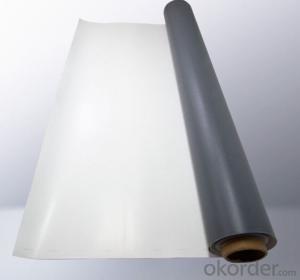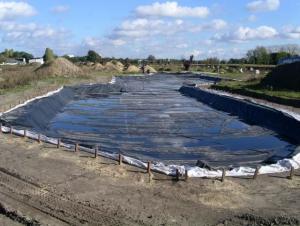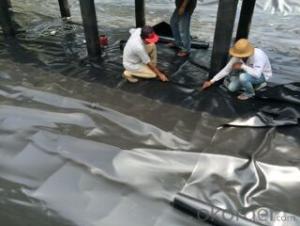EPDM Waterproof Membrane for Roof and Pond
- Loading Port:
- Qingdao
- Payment Terms:
- TT or LC
- Min Order Qty:
- 1000 m²
- Supply Capability:
- 100000 m²/month
OKorder Service Pledge
OKorder Financial Service
You Might Also Like
EPDM Coiled Rubber Waterproof Membrane for Ponds
EPDM Rubber Waterproof Membrane Description:
EPDM waterproof membrane is of high elasticity among high polymer waterproof materials and becomes a world-
popular waterproofing material. EPDM waterproof membrane is made from ternary ethylene-propylene
rubber, which is designed for waterproofing of exposed and non-exposed applications. EPDM waterproof
membrane production adopts the world-advanced equipment of cold feeding extrusion and continuous vulcanization
technology.
Main Features of EPDM Rubber Waterproof Membrane:
1. Excellent physical and mechanical performance
2 High tearing resistance
3 Good deformation adaptability
4 High puncture resistance
5 High aging resistance
6 High UV resistance
Specifications of EPDM Rubber Waterproof Membrane:
Material | EPDM Rubber |
Size | 1.2m (width)*20m (length) or customized, weldable type 2.05m or 4m width |
Thick | 1.2mm, 1.5mm, 2.0mm |
Type | Vulcanized & Weldable |
Pattern | Non-reinforced (homogeneous) |
Certificate | ISO9001/14001 |
Systems
Thanks to a variety of installation systems, the RubberGard EPDM Roofing System provides a solution for even the most challenging rooftops, for both renovation and new built applications.
Products
The RubberGard EPDM Roofing System consists of a high performing EPDM and a complete range of accessories. The combination proven technology offers a unique combination of features & benefits.Technical Information
CNBM Products provides to distributors, contractors, specifiers and building owners a comprehensive range of technical documents, such as specifications, data sheets, type approvals and detail drawings.Installation
It help the contractor installing the RubberGard EPDM Roofing System in accordance with requirements.Training
The RubberGard EPDM Roofing System is exclusively installed by approved roofing contractors that have successfully completed a training program in one of training centers.EPDM Project References
Operating since 3 decades in Europe and Asia, our Products has installed hundreds of thousands of EPDM roofs. The project portfolio includes a selection of major projects.
Images of EPDM Rubber Waterproof Membrane:
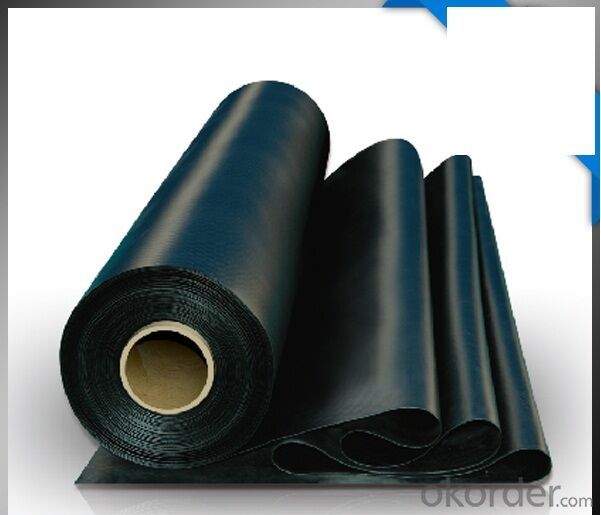
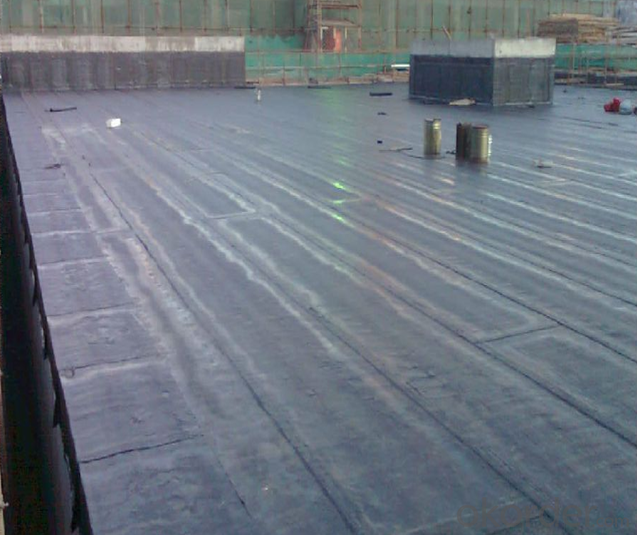
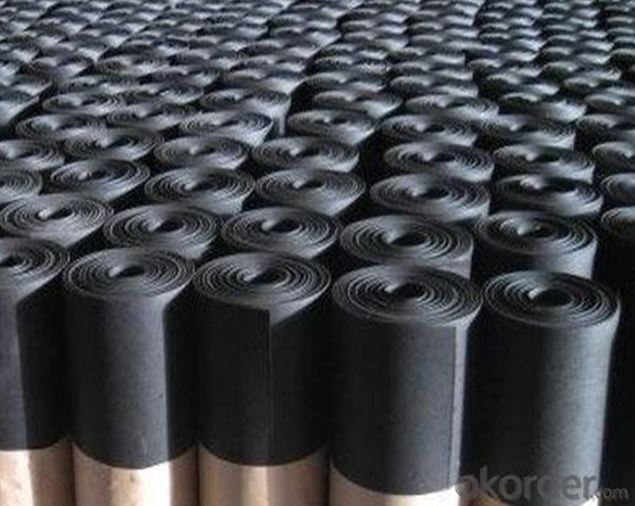
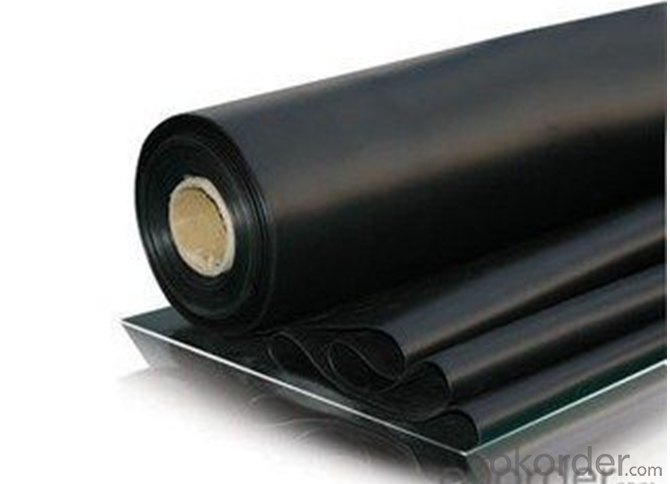
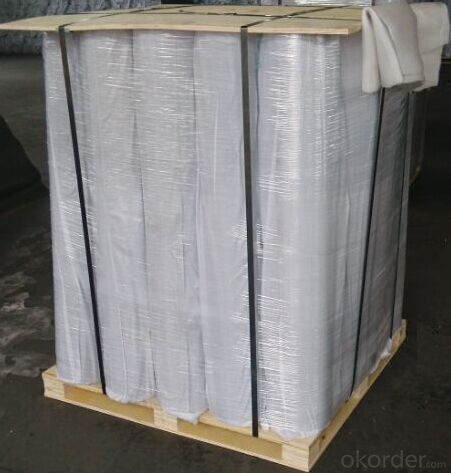
FAQ:
1. What are we supplying?
We are specialized in producing Colorful Asphalt Roof Shingle, SBS/APP modified bitumen waterproof membrane, Self adhesive bitumen
waterproof membrane, PVC waterproofing membrane, EPDM rubber roofing membrane, Single Component Polyurethane Waterproof
Coating, and Spray Polyurea Waterproof Coating
.
2. How Many years experience do we have?
We have been exported to more than 20 countries in the past 15 years.
3. How long do we usually reply your request?
We always reply our customer within 24 hours.
- Q:Are waterproofing membranes resistant to oil and fuel spills?
- Yes, waterproofing membranes are generally resistant to oil and fuel spills. These membranes are specifically designed to create a barrier that prevents water or any other liquid from penetrating through them, including oil and fuel. They are often made from materials such as polyurethane or PVC, which have excellent resistance to various chemicals, including oil and fuel. This makes them suitable for applications where there is a possibility of oil or fuel spills, such as parking garages, industrial facilities, or areas where vehicles are present. However, it is essential to note that the level of resistance may vary depending on the specific type and quality of the membrane used. Therefore, it is crucial to choose a high-quality and appropriate waterproofing membrane that meets the specific requirements of the project to ensure long-term resistance to oil and fuel spills.
- Q:How does a waterproofing membrane handle movement or settling of a building?
- A waterproofing membrane is designed to accommodate movement or settling of a building in a few different ways. Firstly, it is typically installed in such a way that it can stretch or flex as the building moves. This elasticity allows the membrane to remain intact and continue to provide a watertight seal even as the structure shifts or settles. Additionally, waterproofing membranes often incorporate reinforcement materials, such as fabrics or fibers, which enhance their ability to withstand movement. These reinforcements help distribute the stress or strain caused by building movement across a larger area, reducing the risk of tears or failures in the membrane. Furthermore, some waterproofing membranes are designed with built-in features that can accommodate significant movement. For example, certain membranes may have special "crack-bridging" properties, which allow them to span small cracks that may develop in the building's substrate due to settling. This ensures that the membrane remains effective even if the structure experiences minor damage. In cases where a building is expected to undergo significant movement or settling, specialized waterproofing systems, such as joint sealants or expansion joints, may be used in combination with the membrane. These systems are specifically designed to handle large or dynamic movements, providing additional protection against water infiltration. Overall, a waterproofing membrane is carefully designed and installed to handle the movement or settling of a building. Its elasticity, reinforcement materials, and additional features allow it to remain effective in maintaining a watertight seal, even in the face of structural shifts or settlement.
- Q:Can a waterproofing membrane be used for train platforms?
- Yes, a waterproofing membrane can be used for train platforms. Train platforms are exposed to various weather conditions, including rain and snow, which can cause water damage and deterioration over time. By installing a waterproofing membrane on the surface of the train platform, it creates a protective barrier that prevents water from seeping through and causing damage to the underlying structure. This helps to extend the lifespan of the platform, reduce maintenance costs, and ensure the safety of passengers and personnel. Additionally, a waterproofing membrane can also help to prevent the growth of mold and mildew, which can be detrimental to the health of individuals using the train platform. Overall, using a waterproofing membrane on train platforms is a practical and effective solution to protect against water damage and maintain the longevity of the infrastructure.
- Q:How does a waterproofing membrane handle expansion and contraction of a surface?
- The expansion and contraction of a surface are well accommodated by a waterproofing membrane. This membrane is made up of flexible materials that can stretch and contract without compromising its integrity. By doing so, it prevents cracks and damage that could result in water infiltration. Typically, the membrane is installed with overlapping seams, creating a continuous barrier that can expand and contract as necessary. These seams are often reinforced to provide extra strength and durability. Moreover, the membrane is usually applied in multiple layers, enhancing its flexibility and ability to handle surface movement. Aside from the material composition, the installation process plays a crucial role in ensuring the membrane's ability to handle expansion and contraction. Trained professionals take into account specific surface conditions, such as temperature fluctuations and structural movement, and install the membrane accordingly. Techniques like hot-air welding or adhesive bonding may be employed to establish a secure and flexible bond between the membrane and the surface. In summary, a waterproofing membrane is specifically designed to accommodate the natural expansion and contraction of a surface. Its flexibility, reinforced seams, and multi-layer construction enable it to move with the surface while maintaining its ability to prevent water infiltration. This ensures long-term protection against water damage.
- Q:Can a waterproofing membrane be used on plastic block surfaces?
- Yes, a waterproofing membrane can be used on plastic block surfaces.
- Q:Can a waterproofing membrane be used in areas with extreme weather conditions, such as hurricanes or snowstorms?
- Yes, a waterproofing membrane can be used in areas with extreme weather conditions, such as hurricanes or snowstorms. Waterproofing membranes are designed to provide a protective barrier against water infiltration and can effectively withstand various weather conditions. They are made from materials that are resistant to moisture and can be installed in different areas like roofs, basements, or foundations. In regions prone to hurricanes, waterproofing membranes can help prevent water damage by creating a barrier that keeps water out even during heavy rainfall or storm surges. These membranes are often reinforced and have high tensile strength to withstand the strong winds and pressure associated with hurricanes. Similarly, in areas with heavy snowstorms, waterproofing membranes can help prevent water intrusion caused by melting snow or ice dams. They are designed to be flexible and resistant to extreme temperatures, ensuring that they maintain their integrity and prevent leaks even in freezing conditions. However, it is important to choose the right type of waterproofing membrane suitable for the specific weather conditions in the area. Different membranes have varying levels of resistance to extreme weather, so it is advisable to consult with a professional to determine the most appropriate membrane for the specific climate and weather patterns. Additionally, proper installation and regular maintenance are crucial to ensure the longevity and effectiveness of the waterproofing system in extreme weather conditions.
- Q:What are the proper installation techniques for a waterproofing membrane?
- To ensure effective and long-lasting protection against water infiltration, proper installation techniques for a waterproofing membrane involve a series of steps. Here are some guidelines: 1. Start by preparing the surface. It is crucial to have a clean and smooth substrate. Eliminate any loose debris, dirt, or previous coatings. Before moving forward, make sure to repair any cracks or imperfections in the surface. 2. Enhance adhesion between the substrate and the waterproofing membrane by applying a suitable primer. The primer should be compatible with both the substrate material and the membrane. 3. Select a waterproofing membrane that suits the specific application and site conditions. There are different types available, such as sheet membranes, liquid-applied membranes, and self-adhesive membranes. Consider factors like the substrate material, expected movement or stress, and exposure to chemicals or UV radiation. 4. Install the membrane. The exact method may depend on the type of membrane used, but the following general steps apply to most installations: a. Carefully unroll or unfold the membrane, avoiding wrinkles or folds. b. Position the membrane onto the primed surface, ensuring it extends beyond the desired waterproofed area. c. Firmly press the membrane onto the substrate using a roller or trowel, ensuring good contact and eliminating air pockets. d. Overlap the edges of adjacent membrane sheets or sections according to the manufacturer's instructions, typically around 2-3 inches. e. Seal the overlaps securely by applying a suitable seam or joint adhesive. 5. Perform testing and inspection. After installation, it is essential to conduct a comprehensive quality control check. Conduct a flood or water test to verify the membrane's effectiveness in repelling water and to identify any leaks or defects. 6. Protect and finish the installed membrane. Prevent damage during construction activities and enhance durability and resistance to UV radiation or mechanical stress by applying necessary protection layers or coatings. 7. Maintain and repair. Regularly inspect the waterproofing membrane and promptly address any signs of damage, wear, or deterioration. Follow the manufacturer's guidelines for maintenance and perform necessary repairs as soon as possible to maintain the membrane's effectiveness. It is always advisable to consult with a professional waterproofing contractor or follow manufacturer recommendations for the specific membrane being used, as installation techniques can vary.
- Q:Can a waterproofing membrane be used on concrete bridges?
- Concrete bridges can indeed benefit from the use of a waterproofing membrane. These membranes are widely employed to safeguard concrete structures, including bridges, against water-related harm. By applying these membranes onto the concrete surface, a barrier is formed that effectively blocks water infiltration. Their design ensures durability, flexibility, and resistance to various environmental conditions. The utilization of a waterproofing membrane on concrete bridges aids in extending their lifespan by preventing water-induced corrosion of the reinforcement steel, thereby averting structural damage. Furthermore, it mitigates the development of cracks and spalling due to freeze-thaw cycles. In conclusion, the application of a waterproofing membrane offers a highly effective solution for the protection and enhancement of the durability of concrete bridges.
- Q:Is the foundation pit waterproofing and the foundation pouring on the working face?
- 1, foundation pit membrane waterproof is the entire basement part of the package. So the basic floor of the waterproof material and the external walls of the waterproof material as much as possible.
- Q:Can a waterproofing membrane be applied in cold weather or during winter months?
- Yes, a waterproofing membrane can be applied in cold weather or during winter months. However, there are specific considerations and precautions that need to be taken into account. It is important to choose a waterproofing membrane that is specifically designed for cold weather applications. These membranes are formulated to withstand low temperatures and provide effective waterproofing even in freezing conditions. Before applying the membrane, the surface should be thoroughly cleaned and free from any debris, ice, or snow. It is also crucial to ensure that the surface is dry, as moisture can affect the adhesion and performance of the membrane. In cold weather, it may take longer for the surface to dry, so extra time should be allowed for this process. Additionally, the ambient temperature during the application should be within the recommended range specified by the manufacturer. Cold temperatures can affect the curing time of the membrane and may require longer curing periods. It is important to follow the manufacturer's instructions and guidelines for application and curing to ensure proper performance. Moreover, it is advisable to consult with a professional waterproofing contractor who has experience working in cold weather conditions. They can provide expert guidance and ensure that the membrane is applied correctly to achieve the desired waterproofing results. Overall, while it is possible to apply a waterproofing membrane in cold weather or during winter months, it is crucial to choose the right product, prepare the surface properly, and follow the manufacturer's instructions and guidelines to ensure a successful and effective application.
1. Manufacturer Overview |
|
|---|---|
| Location | |
| Year Established | |
| Annual Output Value | |
| Main Markets | |
| Company Certifications | |
2. Manufacturer Certificates |
|
|---|---|
| a) Certification Name | |
| Range | |
| Reference | |
| Validity Period | |
3. Manufacturer Capability |
|
|---|---|
| a)Trade Capacity | |
| Nearest Port | |
| Export Percentage | |
| No.of Employees in Trade Department | |
| Language Spoken: | |
| b)Factory Information | |
| Factory Size: | |
| No. of Production Lines | |
| Contract Manufacturing | |
| Product Price Range | |
Send your message to us
EPDM Waterproof Membrane for Roof and Pond
- Loading Port:
- Qingdao
- Payment Terms:
- TT or LC
- Min Order Qty:
- 1000 m²
- Supply Capability:
- 100000 m²/month
OKorder Service Pledge
OKorder Financial Service
Similar products
New products
Hot products
Hot Searches
Related keywords


